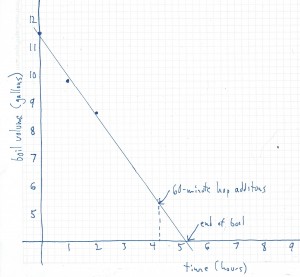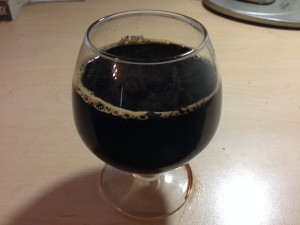This is the sixth article in this series on Russian imperial stouts.

A graphical method of estimating boil time. Plot wort volume vs. time as the boil progresses. Draw a straight line through your data points and extend it until it crosses the line that corresponds to your target wort volume. Work backwards to schedule your hop additions. (Click on picture to enlarge.)
Once you have produced your sweet wort, it’s time for the boil. Depending on the volume of wort you have collected, you may have a “regular-length” or extended boil ahead of you. There are a couple considerations that will apply when boiling any Russian imperial stout wort.
A Russian imperial stout is a big, hoppy beer. As such, there will be a lot of hop debris mixed in with the trub after the boil. You can lose a lot of high-gravity wort to this hop/trub mixture, so you will want to separate as much usable wort from it as possible.
If you have a hop jack, this is a great beer to use it with. Just move the aroma hops you would have added at knockout to the hop jack and use it to strain the hot wort on the way to your chiller. An in-kettle hop strainer or a funnel with a straining screen can also help filter the wort as it is being moved from the kettle to fermenter.
If you don’t have a hop jack, or other means of straining the wort, you could let the chilled wort settle after the boil for an extended amount of time — up to two hours. This will give the hop debris and trub some time to compact. After it has settled, you can draw the clear wort off the top. Additionally, you can save the remaining wort/trub/hop debris sludge in sanitized Mason jars in your fridge overnight. This will allow for additional settling time and allow you to recover a little extra usable wort.
Long Boil
If you require an extended boil, you will need to estimate how long it will take to evaporate the correct amount of water. Boil off rates of 1.0–1.5 gallons per hour (4–6 L per hour) are common among homebrewers. However, the boil off rate for your system may be different. The easiest way to do this is to calibrate a dipstick and make a graph of the wort volume over time. Take an initial wort volume and place a dot on your graph. Every half hour or so, take another reading and plot it. After you have three readings, draw a straight-line through them. Where this line intercepts your volume target will tell you how long you need to boil and when to add your hop additions. Your three points may not form a straight line; if so, draw a straight line that gets as close to all the points as possible. (Or, if you do this in a spreadsheet, use a linear least squares fit.) As you plot more points, you may need to adjust your line a bit. See the first graphic for an example.
 In a long boil, you will want to evaporate water as quickly as possible. However, too much heat applied to too small an area under your kettle can lead to scorching. So, unless you know how high you can turn your burner before it starts to scorch, don’t just “let ‘er rip.” If you plan to brew a lot of big beers with an extended boil, consider investing in a burner that distributes the heat as evenly as possible. Also, if you can adjust your existing burner, you may want to experiment with changing the distance between the burner and the bottom of the kettle. Finally, if you plan to brew a lot of beers with a long boil, consider investing in a kettle that is wider than it is tall. The more surface area of wort that is exposed during the boil, the faster the water will evaporate.
In a long boil, you will want to evaporate water as quickly as possible. However, too much heat applied to too small an area under your kettle can lead to scorching. So, unless you know how high you can turn your burner before it starts to scorch, don’t just “let ‘er rip.” If you plan to brew a lot of big beers with an extended boil, consider investing in a burner that distributes the heat as evenly as possible. Also, if you can adjust your existing burner, you may want to experiment with changing the distance between the burner and the bottom of the kettle. Finally, if you plan to brew a lot of beers with a long boil, consider investing in a kettle that is wider than it is tall. The more surface area of wort that is exposed during the boil, the faster the water will evaporate.
Hops
Russian imperial stout was originally an English style of beer. (It was brewed in England and exported to Russia.) As such, you can use English hops, if you’d like. This would be an especially good choice if you were attempting to brew a historically-inspired Russian imperial stout. On the other hand, there are Americanized versions of this beer, too. Many of these use “citrusy” or “piney” American hops. So, you really can’t make a mistake when picking your hop varieties. Just choose the varieties that you enjoy.
If you would like to minimize the amount of hop debris in your kettle, while not lowering the hop bitterness or aroma, you may want to consider “bookend” hopping. Basically, you will derive nearly all your bitterness from one bittering addition early in the boil, then add all the aroma hops at knockout. If you choose high-alpha hops for bittering, and boil them for 60 to 90 minutes, you will get a high amount of hop bitterness with a relatively small amount of plant material left behind. And, if you reserve all your aroma hops for knock out — or, better yet, put them in a hot jack — you will minimize the amount of hop oil that is lost to evaporation. If you want to add some hops during the middle of the boil for the flavor they give, that is OK. It’s more important to get the hop flavor that you want, than minimize the amount of plant material in the wort.
In the next installment in this series, I will begin to discuss fermentation.
—
Related articles

Would this style lend it self to doing a 2.5 gallon batch (half the volume of the standard) or is it preferred to do the full scale batch?
Would this style also lend itself to experiments with wood aging (maybe decreaseing the late hop additions to let the wood come through)? I have a couple of different woods I would like to try but have never gotten around to it yet but this series has made me think about it again.
You can scale beers up or down. Brewing more or less doesn’t affect the quality (unless you somehow change what the wort or beer experience in the process). Many homebrewers brew less volume of their biggest beers — that way they can still use their regular mash tun and kettle.
And yes, this is one style that gets wood-aged a lot. In fact, at most homebrew competitions, the RISs are a big chunk of the wood-aged beers.
One way to easily increase your evaporation rate is to point a small fan on low or medium at the wort surface or glancing over the top of the pot. It moves the steam out quickly and prevents it from re-condensing into the pot. It will slightly reduce your boil vigor as it draws heat out of the pot faster though, so you will need to compensate by turning up your burner a touch.
@ Dan: generally it is good to have as large of a batch as your system can manage, simply because it takes so much time to age and effort to brew that having a lot to age is good. Many people find this the perfect style to wood age, though be cautious you don’t over do it.
– Dennis, Life Fermented Blog